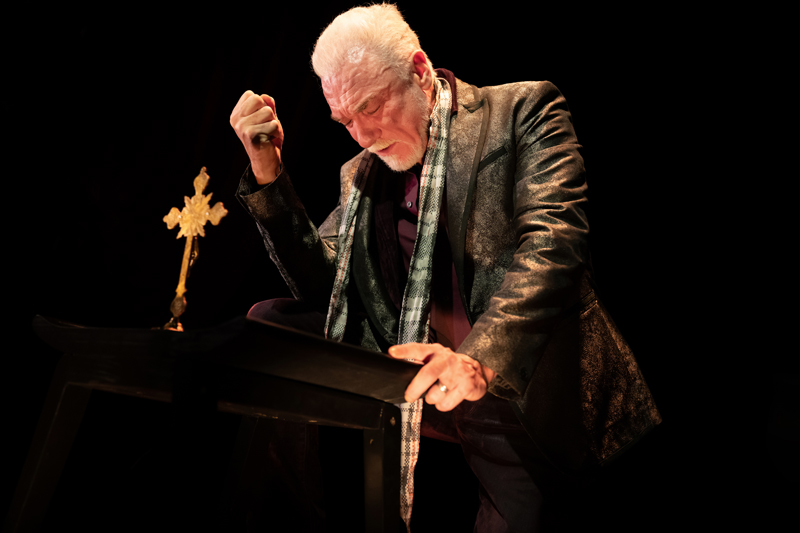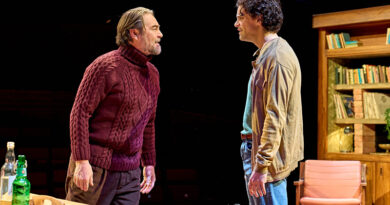“All the Devils Are Here: How Shakespeare Invented the Villain” at the DR2 Theater
Glenda Frank in New York
19 October 2023
Despite the blood-red curtains, the ebony desk with its golden memento mori, and the giant folio on a lectern (Arnulfo Maldonado, set), Patrick Page Hadestown, Casa Valentina) enters the stage in worn jeans (Emily Rebholz, designer), relaxed and chatty. In this off-Broadway production directed by Simon Godwin, Page (playwright and performer) explores Shakespeare’s concept of evil through the evolution of his villains, a passion sparked by Dark Shadows, a gothic television soap opera from the 1960s. The vampire Barnabus Collins introduced Page to his first complex depiction of a sinister protagonist.

Photo credit: Julieta Cervantes.
What a lure! Villains, Shakespeare and Page (a Tony nominee and Grammy Award winner) with that magnificent bass guiding us through the Bard’s changing vision of evil in the manner of a friend rather than a teacher or actor. And he opens with Lady Macbeth (“Unsex me here. . . “) proving that she cast evil spells to summon demons, an obsession of monarch, King James I. “Do those words frighten you?” Page asks. “They scare the hell out of me!”
Page continues with a discussion of morality plays because Shakespeare would have seen them as a boy. The masked Vice figure was an early villain, one-dimensional but still fun. Evil, Page tells us, is sexy. And the dark mysterious shadows behind the curtains and on the walls (dramatic lighting by Stacey Derosier) remind us how much we love to be a little frightened. What Shakespeare developed in his villains was a new psychological complexity, people who chose evil but were a lot like us.
Page weaves in historical tidbits and gossip throughout so creating a rich, colorful tapestry: how the Bard stole from Christopher Marlowe, his two- year bumper crop of love poetry inspired by the Dark Lady, and his purchase of a coat of arms. A review by the university-educated Robert Greene was the first to mention the playwright (“Shake scene”). Greene was outraged. The young playwright, he tells us, is a man reaching above his rank, “a Tygers heart wrapt in a Players hide,” and an “upstart crow, beautified in our feathers.” In other words, a plagiarist! Page has us in his hands and he keeps us there, sometimes breathless at the revelations, for the whole show.
One of the highlights is the key scene between Othello and his advisor Iago as he cunningly plants the seeds of jealousy in the general’s mind. Playing both roles with a change of voice and blocking, the whole play seems to open up before us.
Before we are treated to the closing scene of The Tempest, a challenging question is posed. Why had Shakespeare not continued his investigation into evil? Certainly, Antonio had earned his place among the villains, having usurped Prospero’s dukedom and set his brother and Miranda adrift at night with no provisions. But after Prospero reclaims Milan and tosses away his book and staff, he forgives his brother.
As the 85-minute presentation winds down, Page once more seems like the guy next door and I realized with surprise the wonderful intensity of our voyage through the canon. The stage had been peopled with a dozen villains and a vision unfolded. All the Devils Are Here: How Shakespeare Invented the Villain has an open-ended run.









